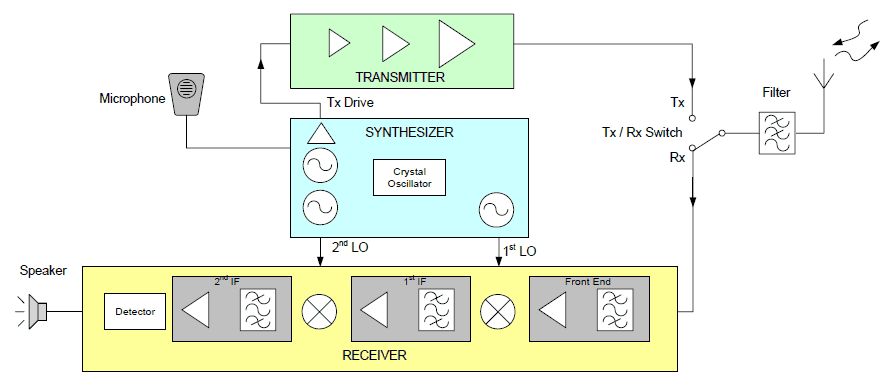 Before we get into the detail of each RF performance parameter, this week, let us discuss the parts that make up a typical radio. This is absolutely crucial to understanding the parameters that affect RF performance.
Before we get into the detail of each RF performance parameter, this week, let us discuss the parts that make up a typical radio. This is absolutely crucial to understanding the parameters that affect RF performance.
Shown below is a very simplified block diagram of the RF part of a typical Tait FM Mobile or Portable radio. Two commonly used abbreviations are introduced here -Tx (ie: Transmitter), and Rx (ie: Receiver). These abbreviations will be used throughout the remainder of this series.

The heart of the RF section is the Synthesizer. Here, the Crystal Oscillator provides a reference frequency from which the Rx 1st LO, Rx 2nd LO and Tx drive signals are derived. Hence, the Crystal Oscillator basically determines the frequency accuracy and frequency stability performance of the radio. In transmit mode, the Synthesizer produces the desired Tx frequency with the modulation (speech or data) super-imposed. The transmitter then amplifies this signal up to the final power level to be transmitted, after which the signal passes through the Tx/Rx Switch before being filtered to remove any unwanted harmonics. In Receive mode, the Tx/Rx Switch is now set to Rx, and all signals picked up by the antenna are fed to the Receiver Front End. Here all the received signals are amplified and then filtered to begin to center in on the desired signal.
The result is then down converted to the 1st Intermediate Frequency (IF) of a few tens of MHz. Here narrower filtering is applied to begin to select the wanted signal and reject any other signals that happen to have been received. This process repeats in the 2nd IF until we are left with only the wanted signal. This signal is then passed to the Discriminator which extracts the information in the form of voice or data, which (in the case of voice, as shown) would be amplified and fed to the speaker.
Tait designs and manufactures three major types of radio. A typical radio system will feature all the three types.
Portables
Examples are the TP9400, TP9100, TP9300 and the TP8100. Portables are designed to be of a size easily carried by an individual user, are lightweight and are battery operated. They are low cost, have a low current consumption (to maximize battery life), but offer only a moderate level of RF Performance. It is the type of radio that would be carried by an on foot Policeman or a Fire Fighter, so they are designed to be physically very rugged given the variety of environments that could be encountered. On a typical radio network there would typically be many portables operating.
Mobiles
Examples of Mobiles are the TM9400, TM9100, TM9300 and the TM8000. Mobiles are designed for installation in vehicles such as Police Cars and Fire Engines, and thus are designed to bepowered from a car battery. Mobiles offer a higher level of RF performance than Portables. Again, on a typical radio network, there would be many Mobiles operating.
Base Stations
Examples of Tait Base Stations are the TB9400, TB9100, TB9300, TB7300, TB7100 and TB8100. Base Stations are the heart of a radio system. They are installed in fixed locations (usually on top of the highest surrounding hill) and are typically powered from mains or solar cells. Base Stations have to handle many RF signals at once, to and from the various Portables and Mobiles on the system, and as such the RF performance is paramount.
In the coming weeks, we will also show you typical RF parameter values for Tait products.



